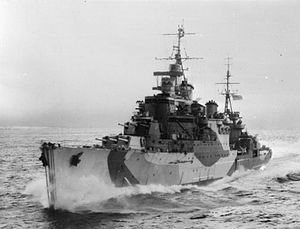HMS Birmingham (C19)

Birmingham in 1943
|
|
| History | |
|---|---|
|
|
|
| Name: | HMS Birmingham |
| Builder: | Devonport Dockyard (Plymouth, U.K) |
| Laid down: | 18 July 1935 |
| Launched: | 1 September 1936 |
| Commissioned: | 18 November 1937 |
| Fate: | Broken up in 1960 |
| General characteristics | |
| Class and type: | Town-class light cruiser |
| Displacement: |
|
| Length: | 558 ft (170 m) |
| Beam: | 61 ft 8 in (18.80 m) |
| Draught: | 21 ft 6 in (6.55 m) |
| Propulsion: |
|
| Speed: | 32 knots (59 km/h) |
| Complement: | 748 |
| Armament: |
|
| Notes: | Pennant number C19 |
HMS Birmingham was a member of the first group of five ships of the Town class of light cruisers. She was built at Devonport Dockyard (Plymouth, United Kingdom), and launched on 1 September 1936.
Birmingham initially joined the 5th Cruiser Squadron on the China Station in January 1938. On the outbreak of the Second World War in September 1939, she left for Malta for a refit before joining the Home Fleet in March–April 1940. Birmingham was a unit of the 18th Cruiser Squadron of the Home Fleet, initially used to patrol off the coast of Norway to prevent German fishing vessels operating in this area. In mid-April Birmingham, Manchester and Cairo escorted a troop convoy to Norway. On 26 April she shelled and sank the German patrol boat Schiff 37 after Schiff 37 rammed and damaged the destroyer Arrow off Norway. In May, Birmingham, in company with Manchester, evacuated 1,500 troops from Åndalsnes. She returned to the UK and was in refit between September–December 1940.
From January until April 1941 Birmingham escorted troop convoys to the Middle East, around the Cape of Good Hope. In May she returned to home waters, and was involved in the hunt for the German battleship Bismarck and heavy cruiser Prinz Eugen. Birmingham had already put to sea from Scapa Flow on a patrol of the Iceland-Faroes passage, and did not end up engaging the German ships. Birmingham then escorted convoy WS-9A from the UK to South Africa arriving on 4 July 1941. Whilst in South African waters, she docked in the Selborne dry dock at Simon's Town for a minor refit, where she was fitted with the Mk 284 and 291 radars and several new anti-aircraft weapons.
...
Wikipedia
